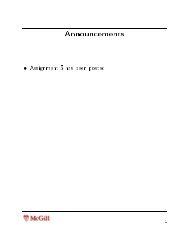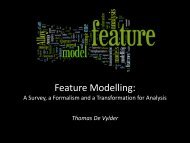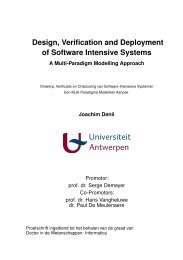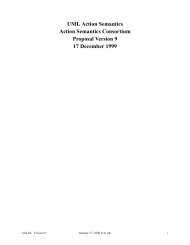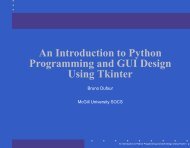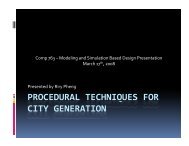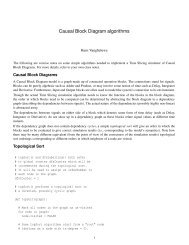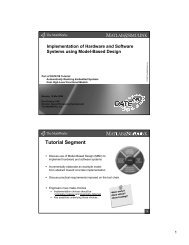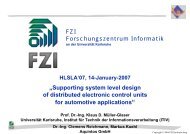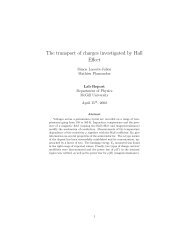Statecharts Modelling of Tank Wars - MSDL - McGill University
Statecharts Modelling of Tank Wars - MSDL - McGill University
Statecharts Modelling of Tank Wars - MSDL - McGill University
Create successful ePaper yourself
Turn your PDF publications into a flip-book with our unique Google optimized e-Paper software.
<strong>Statecharts</strong> <strong>Modelling</strong> <strong>of</strong> <strong>Tank</strong> <strong>Wars</strong><br />
Silvia Mur Blanch<br />
<strong>Modelling</strong>, Simulation and Design Lab<br />
School <strong>of</strong> Computer Science<br />
<strong>McGill</strong> <strong>University</strong>, Montreal, QC, Canada<br />
silvia.murblanch@gmail.com<br />
Abstract. As the video game industry pr<strong>of</strong>its keep increasing faster year<br />
by year, there’s a growing demand for more realistic games, this leading<br />
to a necessity for better AI specification and fast game development<br />
which, consequently, calls for easily reusable AIs. By using modelling languages,<br />
AIs can be specified at a higher level <strong>of</strong> abstraction, allowing the<br />
modellers to focus on the logic <strong>of</strong> the model they are building, instead<br />
<strong>of</strong> having to worry about the implementation issues. The present project<br />
sets out from this proposal, expounded in the paper Model-based Design<br />
<strong>of</strong> Computer-Controlled Game Character Behavior, in which their authors<br />
used the <strong>Statecharts</strong> formalism to demonstrate their approach by<br />
modelling a video game character’s AI.<br />
1 Introduction<br />
Computer games sales have experienced a huge growth in the past few years.<br />
The industry has widely expanded its market targets, nowadays <strong>of</strong>fering variety<br />
and quantity enough to fit every taste and age range. At the same time, the<br />
development <strong>of</strong> more powerful computers and consoles has led to an increasing<br />
demand for more realistic computer games, which doesn’t exclusively mean developing<br />
better physics simulations for water or car crashes. In a first person<br />
shooter or war simulation game, for example, it seems obvious that the enemies<br />
should shelter behind walls or other elements <strong>of</strong> the environment, whenever bullets<br />
are raining down on them. All in all, this means writing better, more complex<br />
AIs, which is becoming harder every time.<br />
The authors <strong>of</strong> the paper Model-based Design <strong>of</strong> Computer-Controlled Game<br />
Character Behavior, on which this project is entirely based, state that AI specification<br />
should be done at a higher level <strong>of</strong> abstraction, that AIs should be<br />
modeled instead <strong>of</strong> coded, so that it could be done by people who don’t necessarily<br />
know any programming languages. And, at the same time, to satisfy a<br />
necessity for reusability, AI specification should be made as modular as possible.<br />
Which would then be the appropriate formalism to use? Given these requirements,<br />
and the fact that these models will define reactions to game events, it<br />
seems obvious that we’ll be looking for a formalism that’s state/event based and<br />
that provides autonomous/reactive behaviour. The formalism that we’ve chosen<br />
is <strong>Statecharts</strong>, since it’s well known by us and we have our very own <strong>Statecharts</strong>
modelling tool, AToM 3 , developed at the <strong>Modelling</strong>, Simulation and Design Lab<br />
(<strong>MSDL</strong>) in the School <strong>of</strong> Computer Science <strong>of</strong> <strong>McGill</strong> <strong>University</strong>.<br />
2 <strong>Modelling</strong> an AI<br />
To demonstrate the approach proposed in the previously mentioned paper,<br />
the authors used the <strong>Tank</strong> <strong>Wars</strong> game by Electronic Arts (EA), thus modelling<br />
a tank’s AI with the <strong>Statecharts</strong> formalism. First <strong>of</strong> all, the tank’s architecture<br />
is abstracted in different layers, each <strong>of</strong> which defines a component or group<br />
<strong>of</strong> components <strong>of</strong> the tank. As well, each layer represents a different level <strong>of</strong><br />
abstraction (see Fig.1).<br />
The tank’s AI will make decisions<br />
based upon the information it gets<br />
from the environment; this data is perceived<br />
by the tank through its sensors,<br />
at the lowest level <strong>of</strong> abstraction,<br />
then refined and passed on to the other<br />
components <strong>of</strong> the tank. The tank will<br />
react to the input it gets by executing<br />
actions; for example, whenever an obstacle<br />
is detected in the tank’s path,<br />
the tank should turn left or right to<br />
dodge it. The event flow in Figure 1<br />
describes the order <strong>of</strong> the transformation<br />
process <strong>of</strong> the input received<br />
through the sensors into the output<br />
given through the actuators.<br />
Fig. 1. <strong>Tank</strong>’s AI architecture<br />
Each components structure is<br />
modeled by a class, and its behavior<br />
by a statechart. Though modelled separately, the components <strong>of</strong> the tank are<br />
orthogonal, which means that the statecharts will run concurrently when the<br />
execution starts, and that the events generated in one statechart can (and definitely<br />
will) trigger transitions in some <strong>of</strong> the other components. For example,<br />
when the InRangeDetector component <strong>of</strong> the tank detects that the enemy is in<br />
the range <strong>of</strong> the turret, it will generate the event readyToShoot, which shall trigger<br />
a transition in the AttackStrategy component and make it change its state<br />
to Shooting.<br />
Figure 2 depicts all the tank’s components put together, and the dependency<br />
between some <strong>of</strong> them. When a component’s functionality depends on data from<br />
another component, synchronous communication must occur.<br />
3 Time-slicing to Event-driven<br />
In the EA <strong>Tank</strong> <strong>Wars</strong> game, information from the environment is provided<br />
to the tank every 50ms. This information includes current tank’s fuel level, cur-
Fig. 2. <strong>Tank</strong>’s AI components<br />
rent tank’s health level, etc. Thus, the main difficult <strong>of</strong> modelling the tank’s AI<br />
using a state/event formalism resided in bridging the gap between the time-sliced<br />
world and the event-based world. So, after compiling the classes and statecharts<br />
into C++, some intermediate code writing was still needed.<br />
Everytime the tank receives input from the environment, the function ai()<br />
is called and, consequently, this is the starting point for the EA <strong>Tank</strong> <strong>Wars</strong> competition<br />
contestant to write his or her own AI code. In the statechart modelling<br />
solution, the input data is processed, causing events to be generated and sent to<br />
tank’s components (statecharts), in order to trigger the appropriate trasitions,<br />
thus obtaining the corresponding reactions (which at the same time may generate<br />
more events that will trigger more transitions) and, finally, translating these<br />
into the AI’s output that will be sent to the game environment in response to<br />
the previous input.<br />
4 Conclusion<br />
The approach proposed in [3] was developed and tested by its authors, being<br />
the tank’s components modelled using the Class Diagrams formalism, where each<br />
component’s structure is described by a class, and its behaviour by a statechart.<br />
The classes and statecharts where implemented using AToM 3 , then compiled<br />
into C++ code, and finally inserted into the EA <strong>Tank</strong> <strong>Wars</strong> main game loop<br />
and successfully run.<br />
However, the statecharts implemented weren’t as detailed as the ones originally<br />
described and, though the authors managed to bridge the event-based
world with the time-sliced world, the whole solution wasn’t as event-based as it<br />
had been initially planned.<br />
In the practical part <strong>of</strong> this project I will try to modelate the tank’s AI<br />
components from scratch, using the more elaborate statechart designs depicted<br />
in [3] and a more simple, self-made simulation environment, instead <strong>of</strong> the EA<br />
<strong>Tank</strong> <strong>Wars</strong> game environment.<br />
References<br />
1. Electronic Arts. EA <strong>Tank</strong> <strong>Wars</strong>. http://info.ea.com/company/company_tw.php,<br />
2005.<br />
2. David Harel. <strong>Statecharts</strong>: A visual formalism for complex systems. Science <strong>of</strong><br />
Computer Programming, 8(3):231–274, June 1987.<br />
3. Jörg Kienzle, Alexandre Denault, and Hans Vangheluwe. Model-based design <strong>of</strong><br />
computer-controlled game character behavior. In ACM/IEEE 10th International<br />
Conference on Model Driven Engineering Languages and Systems, pages 650–665.<br />
Springer Berlin / Heidelberg, 2007.<br />
4. Hans Vangheluwe and Juan de Lara. AToM 3 , A Tool for Multi-formalism and<br />
Meta-<strong>Modelling</strong>. http://atom3.cs.mcgill.ca, 2002.



